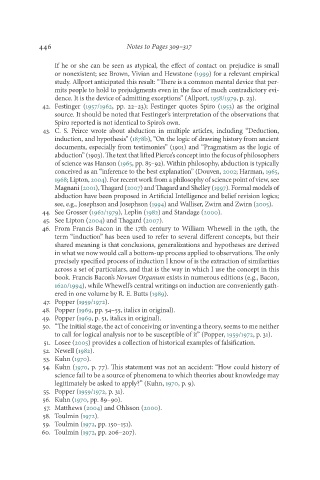Page 463 - Deep Learning
P. 463
446 Notes to Pages 309–317
If he or she can be seen as atypical, the effect of contact on prejudice is small
or nonexistent; see Brown, Vivian and Hewstone (1999) for a relevant empirical
study. Allport anticipated this result: “There is a common mental device that per-
mits people to hold to prejudgments even in the face of much contradictory evi-
dence. It is the device of admitting exceptions” (Allport, 1958/1979, p. 23).
42. Festinger (1957/1962, pp. 22–23); Festinger quotes Spiro (1953) as the original
source. It should be noted that Festinger’s interpretation of the observations that
Spiro reported is not identical to Spiro’s own.
43. C. S. Peirce wrote about abduction in multiple articles, including “Deduction,
induction, and hypothesis” (1878b), “On the logic of drawing history from ancient
documents, especially from testimonies” (1901) and “Pragmatism as the logic of
abduction” (1903). The text that lifted Pierce’s concept into the focus of philosophers
of science was Hanson (1965, pp. 85–92). Within philosophy, abduction is typically
conceived as an “inference to the best explanation” (Douven, 2002; Harman, 1965,
1968; Lipton, 2004). For recent work from a philosophy of science point of view, see
Magnani (2001), Thagard (2007) and Thagard and Shelley (1997). Formal models of
abduction have been proposed in Artificial Intelligence and belief revision logics;
see, e.g., Josephson and Josephson (1994) and Walliser, Zwirn and Zwirn (2005).
44. See Grosser (1962/1979), Leplin (1982) and Standage (2000).
45. See Lipton (2004) and Thagard (2007).
46. From Francis Bacon in the 17th century to William Whewell in the 19th, the
term “induction” has been used to refer to several different concepts, but their
shared meaning is that conclusions, generalizations and hypotheses are derived
in what we now would call a bottom-up process applied to observations. The only
precisely specified process of induction I know of is the extraction of similarities
across a set of particulars, and that is the way in which I use the concept in this
book. Francis Bacon’s Novum Organum exists in numerous editions (e.g., Bacon,
1620/1994), while Whewell’s central writings on induction are conveniently gath-
ered in one volume by R. E. Butts (1989).
47. Popper (1959/1972).
48. Popper (1969, pp. 54–55, italics in original).
49. Popper (1969, p. 51, italics in original).
50. “The initial stage, the act of conceiving or inventing a theory, seems to me neither
to call for logical analysis nor to be susceptible of it” (Popper, 1959/1972, p. 31).
51. Losee (2005) provides a collection of historical examples of falsification.
52. Newell (1982).
53. Kuhn (1970).
54. Kuhn (1970, p. 77). This statement was not an accident: “How could history of
science fail to be a source of phenomena to which theories about knowledge may
legitimately be asked to apply?” (Kuhn, 1970, p. 9).
55. Popper (1959/1972, p. 31).
56. Kuhn (1970, pp. 89–90).
57. Matthews (2004) and Ohlsson (2000).
58. Toulmin (1972).
59. Toulmin (1972, pp. 150–151).
60. Toulmin (1972, pp. 206–207).

